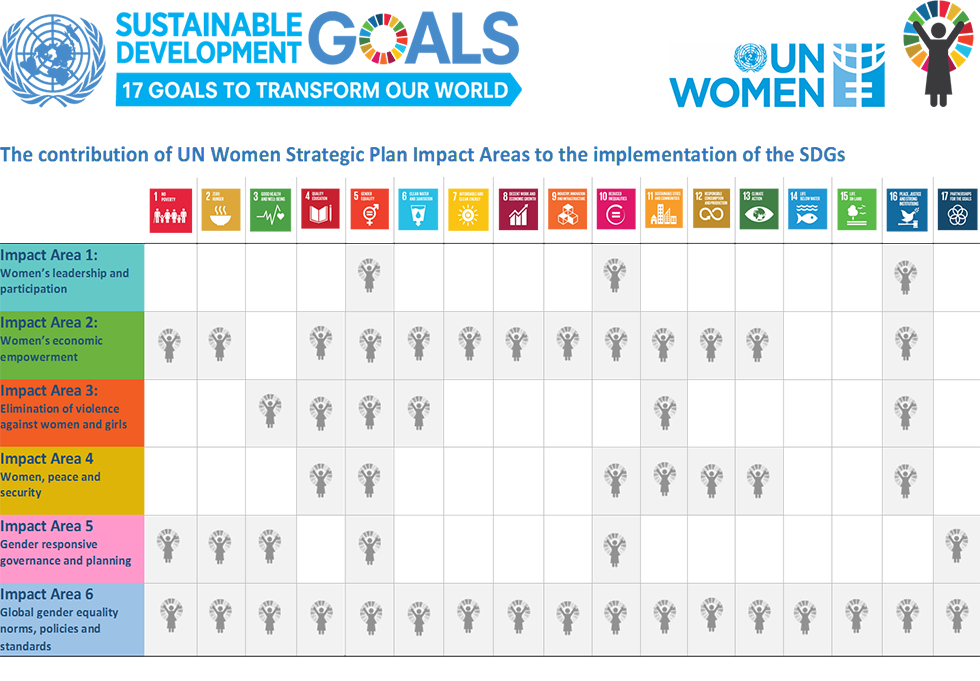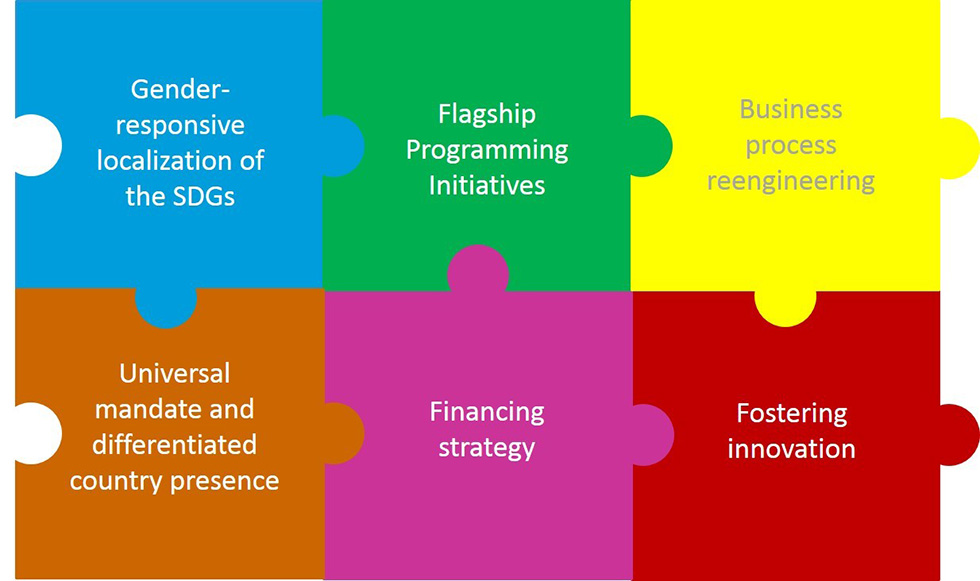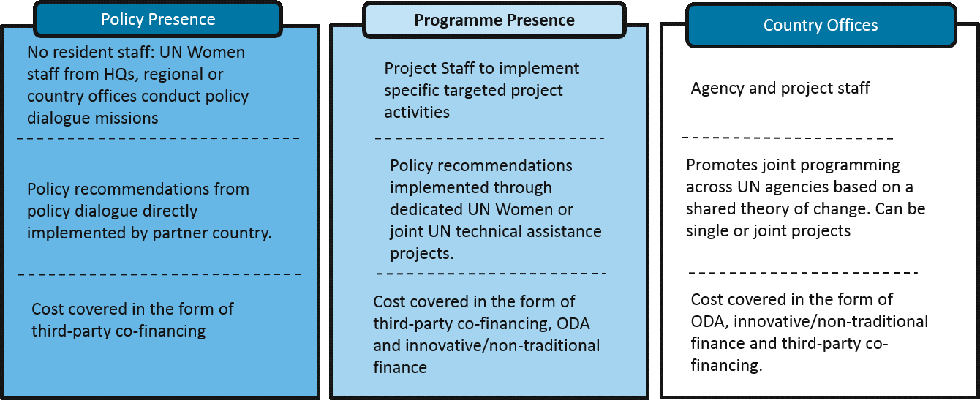Midterm analysis
Overview | Snapshot of results | Midterm analysis | Financial resources | Related links
Impact areas: Leadership & political participation | Economic empowerment | Ending violence against women | Peace & security & humanitarian action | National planning & budgeting | Global norms, policies & standards
Based on an analysis of results to date and a review of independent evaluations and assessments, the Midterm Review has identified a number of findings and lessons learned from the first two years of implementation. In response to these findings, UN Women has proposed six strategic initiatives to address lessons learned and further enhance the implementation of the Strategic Plan and achievement of results in 2016-2017.
Lessons learned
Relevance of the strategic plan
UN Women’s strategic plan continues to be relevant and contributes to the implementation of the Beijing Declaration and Platform for Action. This was confirmed by several independent evaluations and assessments and the steady progress registered against targets. Evaluations have also emphasized the strong alignment of UN Women’s programming with national priorities and the high level of national ownership for UN Women programmes. The strategic plan has allowed for sufficient flexibility to adapt to emerging issues, such as climate change or migration.
The strategic plan contributes to the implementation of the 2030 Agenda with each impact area synergistically contributing to the achievement of multiple SDGs.

Successfully leveraging the triple mandate
UN Women’s ability to leverage its triple mandate of normative support, UN coordination, and operational activities has been an enabler of success and represents a major asset. Leveraging the triple mandate has been particularly fruitful in multisectoral areas, such as ending violence against women and girls, or women, peace and security.
UN Women has been particularly successful in strengthening global frameworks and translating them into national and regional standards. UN Women’s normative and coordination mandates have also contributed to elevating issues within UN country teams and strengthening national dialogue in support of gender equality.
More can be done to take full advantage of synergies across mandates and build greater capacity for UN coordination, especially at the country level.
Strong partnerships as results enablers
UN Women’s partnership with gender equality advocates has played a key role in achieving results. UN Women’s convening role and its ability to build and coordinate multi-stakeholder coalitions have been recognized by Governments and civil society alike as a major asset. In addition, UN Women’s unique relationship with the women’s movement was highlighted by several partners consulted for the Midterm Review. Private sector partners consulted for this review noted that UN Women has been successful at building partnerships based on substance and common goals and that leverage expertise and reach in support of results.
The importance of engaging the non-committed is also essential to transformative change. UN Women has sought to expand its reach to constituencies beyond traditional allies, particularly in the last two years. UN Women has engaged men and boys, faith-based organizations, youth and the media in various ways.
Challenges include a level of fragmentation in the work of gender equality advocates, calling for greater focus and coordination to scale up results. Also, the expansion of constituencies and target groups can create debate among closest allies, thus requiring careful calibration and balancing.
Programmatic focus and operational effectiveness
Despite its successful delivery of results overall, UN Women needs to improve its programmatic focus to use its limited resources strategically. UN Women identified the need to consolidate a large number of small-scale, short-duration, UN Women-only projects into a small number of larger, multi-stakeholder transformative programmes.
Despite gradual improvements, UN Women still faces operational bottlenecks, cumbersome procedures or unclear processes that can result in delays in fund disbursement, reporting or other challenges and this needs to be addressed.
Resource constraints
UN Women continues to be hampered by resource constraints that prevent sustainability and scaling-up of successful interventions. Ensuring adequate financing will be critical to the successful implementation of the 2030 Agenda. At the same time, UN Women can do more to track resource gaps and quantify its implications.
Strategic initiatives
To address these lessons, UN Women is enhancing its programming modalities, business processes, organizational design, and financing and innovation strategy, while taking into account the evolving development landscape, with particular attention to ongoing processes related to SDG implementation.

Gender-responsive localization of the SDGs
Together with the UN system, UN Women supports Member States to integrate the SDGs into their development plans, budgets, institutional arrangements, and statistical systems. UN Women’s priority is to ensure that these localization processes fully support a gender-responsive implementation of the 2030 Agenda.
As part of UN Country Teams, UN Women will leverage expertise in gender-responsive planning and budgeting to integrate the 2030 Agenda into national planning processes in a gender-responsive manner and translate the SDGs into development strategies and fiscal plans that benefit women and girls.
At the global level, UN Women will build multi-stakeholder coalitions to accelerate progress on specific targets in SDG 5, such as closing the gender pay gap or unpaid care work. It will also leverage the UN-SWAP, and its coordination mandate, in support of joint action.
To ensure that no one is left behind in the implementation of the 2030 Agenda, and in line with the Strategic Plan’s principles of inclusiveness and focusing on the poorest and most excluded groups, UN Women will tackle the root causes of multiple and intersectoral discrimination and structural inequalities.
Programming modalities: Flagship Programming Initiatives
Flagship Programming Initiatives (FPIs) respond to a number of lessons learned in the last two years. They reflect an evolution in UN Women’s programming modalities and aim to consolidate a large number of small-scale, short-duration UN Women only projects into a small number of larger multi-stakeholder transformative programmes.
Guided by international agreements, FPIs enable UN Women to fully leverage its unique composite mandate, as well as to strengthen normative-operational linkages, in support of transformative change. Based on comprehensive theories of change, FPIs provide a common platform for UN Women and partners to map ongoing activities contributing to gender equality in a specific area and to identify areas to be addressed. FPIs are high-impact, scalable, multi-stakeholder programmes that fully leverage partnerships in support of results. As they address multiple SDGs in a synergistic manner, the FPIs are not only instrumental to achieving gender equality; they also contribute to achieving other goals.
The FPIs constitute a key part of UN Women’s financing strategy, as they enable access to high-quality non-core funding, allow donors to earmark funds at the thematic level, and complement country-level allocations.
Operational support: business processes re-engineering
To support its programming, UN Women requires effective and efficient operational systems and business processes to ensure that it can deliver on time, on scope and on budget. UN Women launched a business-process mapping and re-engineering initiative to identify bottlenecks, streamline systems and processes and design optimized, efficient and effective delivery platforms. This initiative will strengthen a culture of results-based management, accountability and improved stewardship of resources. UN Women is investing in programme management systems to improve key functions and support decentralized decision-making.
Organizational design: delivering on the universal mandate
Given its universal mandate, UN Women is well positioned to respond to the universal nature of the 2030 Agenda. Following the swift roll-out of its regional architecture, UN Women has a diversified country presence, with regional, multi-country and country offices, as well as programme presences.
Based on the ongoing evaluation of the regional architecture, UN Women will further adapt its organizational design to respond to the universal nature of the SDGs. UN Women will tailor its normative, coordination and operational role to each context.

Financing strategy
In order to close its resource gap, UN Women will continue its efforts to meet resource targets approved by the Executive Board for the institutional budget. UN Women will continue to work to ensure an adequate level of core resources, as they provide UN Women with the institutional capacity which underpins UN Women’s normative and coordination functions and provides the necessary foundation to leverage non-core resources.
UN Women will also focus on attracting high-quality, soft-earmarked non-core resources, through its Flagship Programming Initiatives and by continuing to promote the successful experience in direct funding of strategic notes at the country level.
In addition, UN Women will seek innovative sources of financing, including with the private and philanthropic sectors. UN Women will also work more systematically to fully leverage UN pooled funding mechanisms (UN Trust Funds, Joint Programmes).
Fostering innovation
Achieving gender equality requires transformation of social structures, value systems, institutions, behaviours and practices. Innovative approaches that disrupt “business as usual” can significantly help to leapfrog progress.
UN Women supports open innovation, as well as targeted innovation in support of transformative results. Open innovation promotes the engagement of a broader base of partners and individuals to generate ideas and solution-building. In addition to open innovation, UN Women also proactively targets barriers and issues where progress is slow and where more dramatic departures from traditional programmatic and policy work are required.
For example, targeted innovation is being pursued for programmatic innovation by leveraging ICTs and new business models to scale up impact; operational innovation in support of business processes; and financial innovation to deepen financial intermediation services for women.
UN Women will also continue to develop innovative approaches to partnerships and convening stakeholders, creative ways of generating and capturing knowledge, and behaviour change initiatives.
Overview: Midterm Review of the Strategic Plan, 2014-2017
The charts below allow you to look at progress across the first two years of the Strategic Plan. For the full report, please click here.
For more information, see related links »
Overview | Snapshot of results | Midterm analysis | Financial resources | Related links
Impact areas: Leadership & political participation | Economic empowerment | Ending violence against women | Peace & security & humanitarian action | National planning & budgeting | Global norms, policies & standards